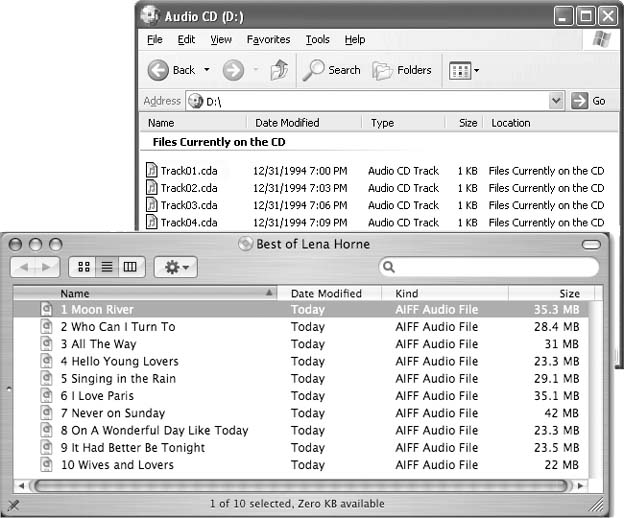Recorded music has appeared in a variety of shapes and sizes over the decades, including fragile discs spinning at 78 rpm, vinyl records in colorful sleeves that were artworks in themselves, pocket-size cassette tapes, and futuristic-looking compact discs. But no music format ever exploded into the public consciousness as quickly and widely as the bits of computer code known as MP3 files.
The MP3 format makes it possible to compress a song into a file small enough to be uploaded, downloaded, emailed, and stored on a hard drive. That feat of smallness set off a sonic boom in the late 1990s that continues to reverberate across the music world today.
This chapter tells all about MP3 and other music formats, including the main iPod-approved format: AAC (Advanced Audio Coding), a copy-protected file type that makes Apple’s iTunes Music Store possible.
The era of modern digital audio began in the early 1980s. A new, small, shiny format called the audio compact disc, developed by Sony and Philips, began to appear in music stores alongside tapes and vinyl records. Unlike analog tapes and LPs, audio CDs stored music in digital form, and produced a bright, clean sound with pristine clarity. (Some audiophiles still prefer the “warmer” sound of vinyl, not to mention the expansive canvas that records provided for detailed album artwork, but many have accepted the CD.)
1985 was a pivotal year for the CD. The format’s popularity got a huge boost from its first big seller, Brothers in Arms by Dire Straits, and a variation on the audio CD technology called CD-ROM (Compact Disc, Read-Only Memory) edged into the computer market as a way to play multimedia files and interactive programs.
Over the years, a CD drive became a standard component of a computer. On most audio CDs, songs are stored in a format called CD-DA (Compact Disc, Digital Audio), which is essentially the same thing as the AIFF format (Section 4.3.3).
On a Windows PC, if you inspect the contents of a music CD, you see a screenful of names like Track01.cda. These turn out to be nothing but 1 KB files that point to the hidden audio tracks, as shown in Figure 4-1. Mac OS X displays the audio tracks in all their hefty glory as AIFF files, right in the Finder window (it even shows you song titles, if it can find them after a quick bit of Internet searching).
Figure 4-1. Left: Here’s what a desktop window looks like for a music CD inserted into a Mac: just like an MP3 playlist, except these AIFF files are much larger. Your computer can play these high-quality files, but they eat up a lot of hard drive space.Right: Audio files are more bashful when a disc is inserted into a Windows drive. The tracks on this CD remain hidden behind tiny pointer files; you can lure them out only with CD-extraction software.
Even if you can’t see the audio files, you can still extract them from the CD with software. “Extracting audio tracks” may sound like an uncomfortable medical procedure, but it means copying them from the CD to your hard drive in a computer-readable format. You may also hear the term ripping CDs, which is the same thing.
And while you’re digesting new-millennium terminology: Once the music files are on your Mac or PC, you encode them into a compressed audio format like MP3 or AAC so that more music fits on a CD that you burn—or on a music player like the iPod.
Get iPod & iTunes: The Missing Manual, Fourth Edition now with the O’Reilly learning platform.
O’Reilly members experience books, live events, courses curated by job role, and more from O’Reilly and nearly 200 top publishers.


